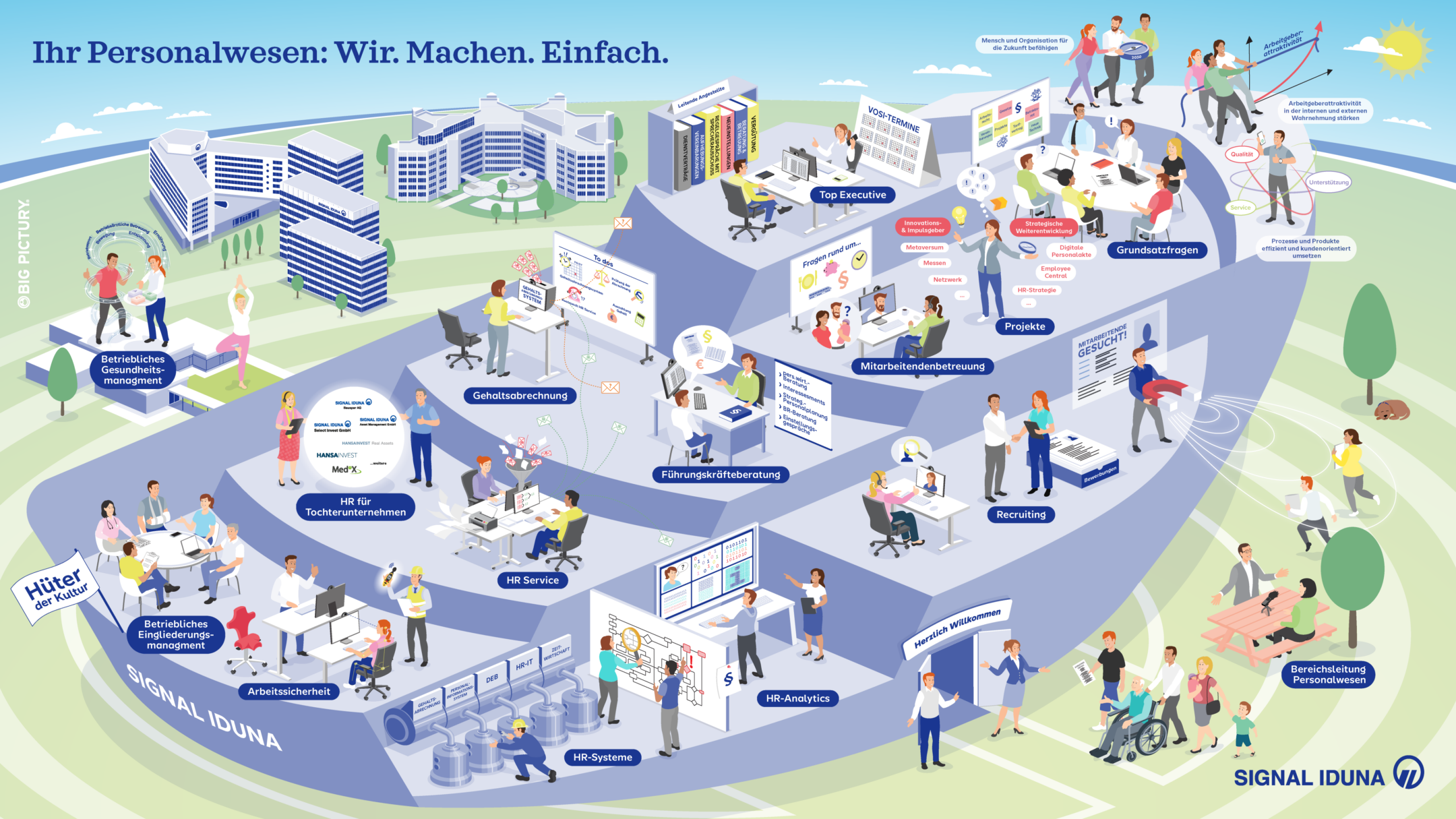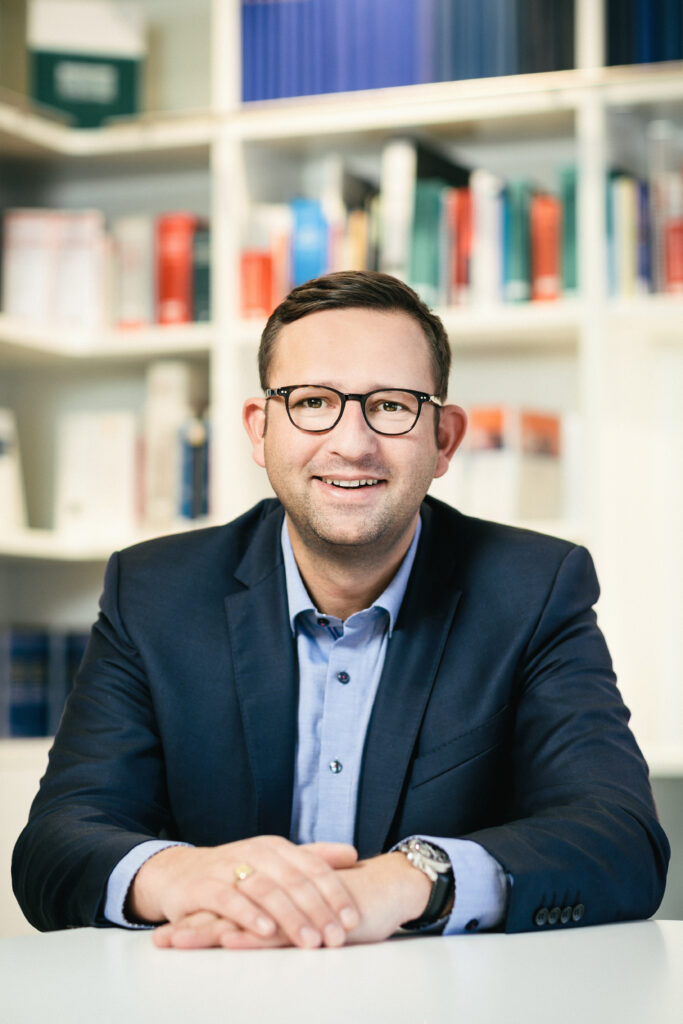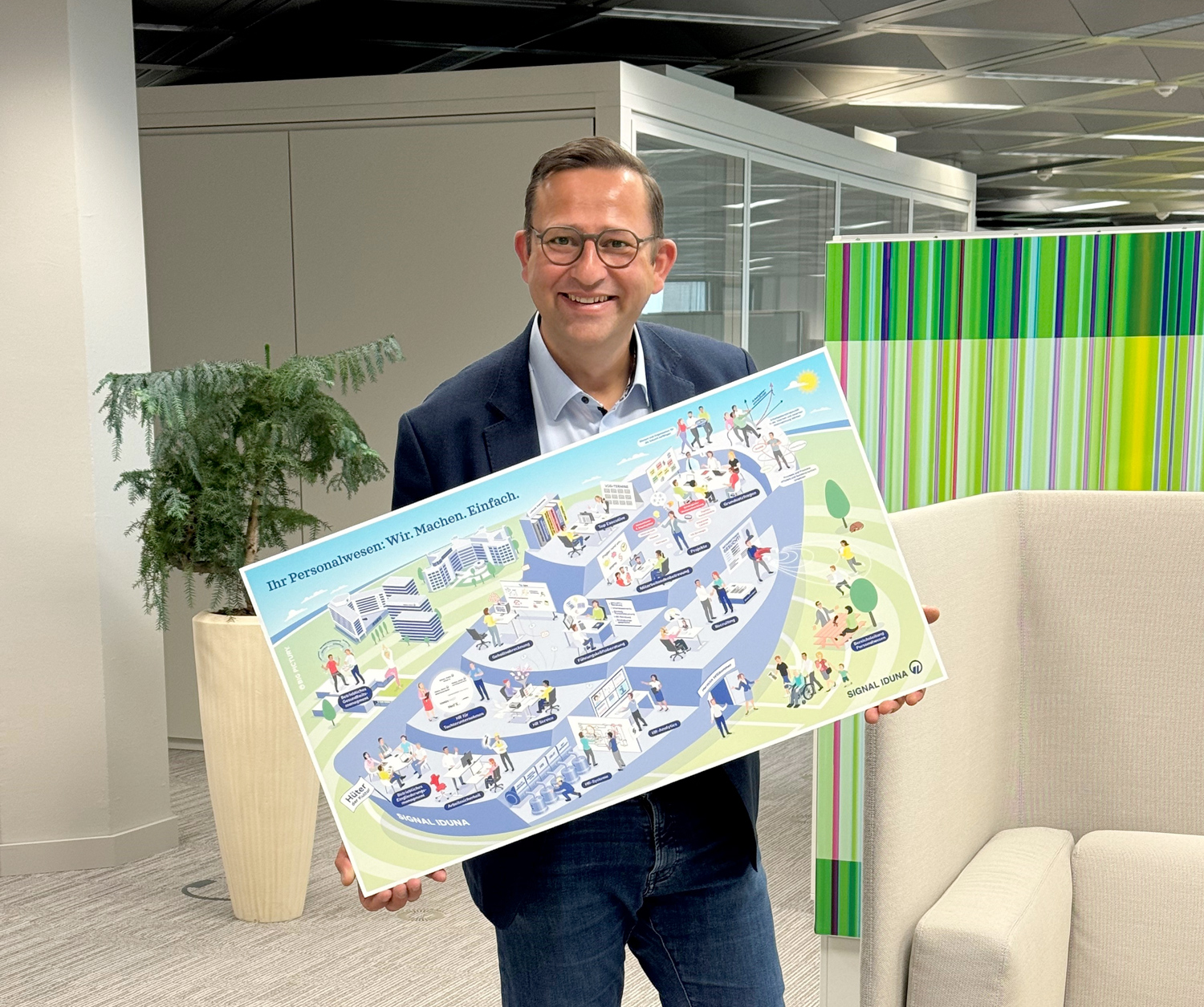We asked Tobias Vögele, Head of Human Resources at the SIGNAL IDUNA Group, how he and his team perceived the Big Picture development process. Together, we developed a Big Picture that visualizes the organizational structure of the human resources department and thus facilitates communication with internal customers.
Big Picture: Tobias, could you briefly explain why there is an increased need for communication in the human resources department?
Tobias Vögele: Of course. For more than two decades, our human resources structure has grown organically and to some extent inorganically. Originally a classic administrative department, valued primarily for its administrative skills, we found ourselves confronted with new conditions and increased expectations. Under new management in 2021, we therefore decided to adjust the organizational structure. We aligned our organization consistently with customer needs, differentiated between customer groups and replaced the rather generalist job profile with highly specialized units. In addition, strategic tasks were removed from day-to-day business and handled by cross-functional teams.
Big Pictury: How did you come to decide on a big picture, and how have these changes been translated into images?
Tobias Vögele: A picture is worth a thousand words. Complex structures in particular are much easier to understand in this way. Big Pictury’s representations are so simplified and yet so clear that they reveal their message without explanation. We therefore decided on a Big Picture to illustrate the organizational structure and range of services of our newly established human resources department, particularly for internal customers. This now playfully visualizes the teams and how they work together. We chose a visual world with a ship metaphor as a basis: our organization is connected by a common mission. Each team contributes to achieving common goals and safely reaching the next port. With the Big Picture, we are making our organization transparent for the first time and inviting people to get in touch with us.

Big Pictury: How do you use the finished Big Picture in your communication with internal customers?
Tobias Vögele: After the personal introduction of the Big Picture at numerous events, posters with the Big Picture were distributed at all our locations. When our teams communicate within the company, the formats each carry sections of the Big Picture. This means that customers always know exactly which part of the organization is responsible for the measure. In addition, the Big Picture appears on the intranet on the homepage of the human resources department. There, users can click on the image sections of the individual teams and receive a more detailed description of their missions, as well as the option to contact them directly.
QUICK-FACTS
CLIENT: SIGNAL IDUNA Gruppe
SCOPE OF SERVICES: Development of a big picture for digital and print as well as an interactive click picture
PROJECT PERIOD: 2 months
BUDGET: five figures
Big Pictury: How did you perceive the process of developing the image?
Tobias Vögele: The collaboration was excellent and a real pleasure. From the outset, we had a permanent point of contact who understood and implemented our goals, wishes and restrictions. She was available at short notice to promptly clarify any questions that arose and proactively made suggestions that enriched our internal discussions. Nevertheless, excellent ideas often only emerge from joint discussion and an iterative approach is therefore recommended. The joint loops were always helpful in this process and the appointments were always efficient. We were also impressed by the pragmatic approach right up to the end.
Incidentally, the journey towards the big picture can be of value to an organization, because translating one’s own activities into a meaningful image is often difficult in practice. What are our core tasks and what are we not doing? This aspect was also crucial for us.
Big Pictury: What were the special challenges of this project?
Tobias Vögele: We wanted to involve the employees of the human resources department in all teams and therefore designed the process so that everyone could participate. The results collected in this way then had to be consolidated and incorporated into a big picture. In addition, the content had to be interlinked in such a way that viewers also understand how we work together internally. Misleading representations and unwanted messages had to be avoided. This meant a considerable amount of work, but it was more than worth it. Despite these tasks, the team was always keen to work on the Big Picture because everyone was curious about the result.
Big Pictury: What was the response of the employees to the Big Picture?
Tobias Vögele: The publication of the Big Picture on the contact person structure and the range of services offered by the human resources department met with positive feedback from the HR organization and our internal customers without exception. Our own employees are pleased to see themselves and their tasks in the presentation and feel even more part of a strong HR community. The reluctance of internal customers to contact the HR department about their own concerns is being reduced and it is becoming easier to find the relevant internal contact persons. In some cases, the Big Picture is used at internal events, e.g. as part of the onboarding process for new employees, or – in whole or in part – in presentations.
Big Pictury: Our customers often ask about measurable successes – have you had any yet?
Tobias Vögele: We receive noticeably fewer inquiries from our customers that first have to be referred to the responsible offices (so-called misdirected items). The level of awareness of employee support as the first point of contact for SIGNAL IDUNA Group employees has increased by an estimated 30%.
Big Pictury: Great, thank you very much for your feedback and insights!

“In a working world that is becoming ever more complex, the importance of open and transparent information and communication is constantly increasing. With the Big Picture of the human resources sector, we at the SIGNAL IDUNA Group are therefore breaking new ground in marketing our organization and our range of services to our customers within our own organization. After all, we too have to prove our value proposition again and again and inspire our employees time and again!”
About SIGNAL IDUNA
At the beginning of the 20th century, tradesmen and business owners in Dortmund and Hamburg founded small pension funds, which later became the SIGNAL IDUNA Group. SIGNAL IDUNA also includes specialty insurers for the public sector and a full range of modern financial services. These include, for example, home loan savings products, real estate financing and investment funds. The group’s core competence is in providing coverage for all the risks of life for private households and in customized risk coverage for small and medium-sized businesses. The SIGNAL IDUNA Group currently has more than 11,000 employees and generates premium income of almost seven billion euros. It serves more than twelve million insured persons and contracts.
